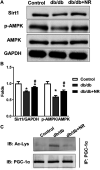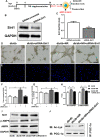Nicotinamide Riboside Enhances Endothelial Precursor Cell Function to Promote Refractory Wound Healing Through Mediating the Sirt1/AMPK Pathway
- PMID: 34054544
- PMCID: PMC8149616
- DOI: 10.3389/fphar.2021.671563
Nicotinamide Riboside Enhances Endothelial Precursor Cell Function to Promote Refractory Wound Healing Through Mediating the Sirt1/AMPK Pathway
Abstract
Lack of vascularization is directly associated with refractory wound healing in diabetes mellitus (DM). Enrichment of endothelial precursor cells (EPCs) is a promising but challenging approach for the treatment of diabetic wounds. Herein, we investigate the action of nicotinamide riboside (NR) on EPC function for improved healing of diabetic wounds. Db/db mice that were treated with NR-supplemented food (400 mg/kg/d) for 12 weeks exhibited higher wound healing rates and angiogenesis than untreated db/db mice. In agreement with this phenotype, NR supplementation significantly increased the number of blood EPCs and bone marrow (BM)-derived EPCs of db/db mice, as well as the tube formation and adhesion functions of BM-EPCs. Furthermore, NR-supplemented BM-EPCs showed higher expression of sirtuin 1 (Sirt1), phosphorylated adenosine monophosphate-activated protein kinase (p-AMPK), and lower expression of acetylated peroxisome proliferator-activated receptor γ coactivator (PGC-1α) than BM-EPCs isolated from untreated db/db mice. Knockdown of Sirt1 in BM-EPCs significantly abolished the tube formation and adhesion function of NR as well as the expression of p-AMPK and deacetylated PGC-1a. Inhibition of AMPK abolished the NR-regulated EPC function but had no effect on Sirt1 expression, demonstrating that NR enhances EPC function through the Sirt1-AMPK pathway. Overall, this study demonstrates that the oral uptake of NR enhances the EPC function to promote diabetic wound healing, indicating that NR supplementation might be a promising strategy to prevent the progression of diabetic complications.
Keywords: adenosine monophosphate–activated protein kinase; diabetes mellitus; endothelial precursor cells; nicotinamide riboside; sirtuin 1; wound healing.
Copyright © 2021 Wang, Bao, Hu, Shen, Xu and Wu.
Conflict of interest statement
The authors declare that the research was conducted in the absence of any commercial or financial relationships that could be construed as a potential conflict of interest.
Figures






Similar articles
-
Rosiglitazone accelerates wound healing by improving endothelial precursor cell function and angiogenesis in db/db mice.PeerJ. 2019 Oct 17;7:e7815. doi: 10.7717/peerj.7815. eCollection 2019. PeerJ. 2019. PMID: 31637120 Free PMC article.
-
Depletion of NAD pool contributes to impairment of endothelial progenitor cell mobilization in diabetes.Metabolism. 2016 Jun;65(6):852-62. doi: 10.1016/j.metabol.2016.03.006. Epub 2016 Mar 15. Metabolism. 2016. PMID: 27173464
-
Metformin improves the angiogenic functions of endothelial progenitor cells via activating AMPK/eNOS pathway in diabetic mice.Cardiovasc Diabetol. 2016 Jun 18;15:88. doi: 10.1186/s12933-016-0408-3. Cardiovasc Diabetol. 2016. PMID: 27316923 Free PMC article.
-
Nicotinamide riboside attenuates alcohol induced liver injuries via activation of SirT1/PGC-1α/mitochondrial biosynthesis pathway.Redox Biol. 2018 Jul;17:89-98. doi: 10.1016/j.redox.2018.04.006. Epub 2018 Apr 5. Redox Biol. 2018. PMID: 29679894 Free PMC article.
-
Role of mitochondria in diabetic peripheral neuropathy: Influencing the NAD+-dependent SIRT1-PGC-1α-TFAM pathway.Int Rev Neurobiol. 2019;145:177-209. doi: 10.1016/bs.irn.2019.04.002. Epub 2019 Jun 8. Int Rev Neurobiol. 2019. PMID: 31208524 Free PMC article. Review.
Cited by
-
AMPK/SIRT1 Deficiency Drives Adjuvant-Induced Arthritis in Rats by Promoting Glycolysis-Mediated Monocytes Inflammatory Polarization.J Inflamm Res. 2022 Aug 15;15:4663-4675. doi: 10.2147/JIR.S378090. eCollection 2022. J Inflamm Res. 2022. PMID: 35996683 Free PMC article.
-
Mitochondrial abnormality in ovarian granulosa cells of patients with polycystic ovary syndrome.Mol Med Rep. 2024 Feb;29(2):27. doi: 10.3892/mmr.2023.13150. Epub 2023 Dec 22. Mol Med Rep. 2024. PMID: 38131196 Free PMC article.
-
Liquid plasma promotes angiogenesis through upregulation of endothelial nitric oxide synthase-induced extracellular matrix metabolism: potential applications of liquid plasma for vascular injuries.Cell Commun Signal. 2024 Feb 19;22(1):138. doi: 10.1186/s12964-023-01412-w. Cell Commun Signal. 2024. PMID: 38374138 Free PMC article.
-
Nicotinamide Riboside Augments Human Macrophage Migration via SIRT3-Mediated Prostaglandin E2 Signaling.Cells. 2024 Mar 5;13(5):455. doi: 10.3390/cells13050455. Cells. 2024. PMID: 38474420 Free PMC article.
-
Axonal Protection by Oral Nicotinamide Riboside Treatment with Upregulated AMPK Phosphorylation in a Rat Glaucomatous Degeneration Model.Curr Issues Mol Biol. 2023 Aug 25;45(9):7097-7109. doi: 10.3390/cimb45090449. Curr Issues Mol Biol. 2023. PMID: 37754233 Free PMC article.
References
-
- American Diabetes Association (2018). National Diabetes Statistics Report. Diabetes Care 2018, dci180007. 10.2337/dci18-0007 - DOI
LinkOut - more resources
Full Text Sources
Other Literature Sources
Molecular Biology Databases
Miscellaneous

